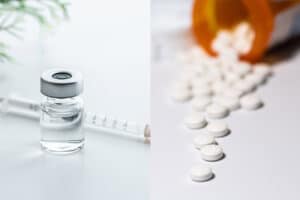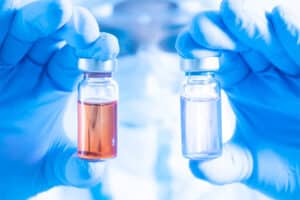Without stabilization in areas such as physical (withdrawal and medicine), mental (identifying mental illness issues), and social (concurrent, dependent, anti-social behaviors), recovery from addiction is very difficult. Therapy helps patients gain insight not only into their particular situation but also it helps to predict pitfalls and helps to develop plans and strategies to move forward in their lives and reach desired goals.
Using Therapy in OUD Treatment
Years ago, when Brightside first started treating OUD (opioid use disorder) patients, the current studies showed that positive outcomes for opioid addiction did not increase with the use of therapy. In looking more closely at those studies, we realized that the individuals in the groups that were being studied were very narrowly chosen and did not include those with comorbidities or dual diagnosis. So, therapy strictly for opiate addiction did not seem to increase the success rate.
Once we started to gain experience in the reality of actually treating the majority patient demographic, we realized that it is much more complicated than we previously thought; most OUD patients have other issues. Some are “dependent comorbidities” and some are “independent comorbidities,” meaning that some are caused by the drug use and other problems are part of the patient prior to their drug use.
The problems that patients may have can be external or internal. The external problems are usually caused by the patient’s drug use (dependent comorbidities) and can be antisocial behaviors like lying, theft, or reclusiveness. They can also be mental or psychological issues such as drug related dysphoria (i.e., depression, psychosis, fear of withdrawal symptoms, etc.).
Due to the fact that many of our patients have multiple other issues, we realized that therapy is extremely useful to help the patient overcome those problems and disadvantages of having dual diagnosis or comorbidities, whether dependent or not. Chances of increased overall patient health and happiness are greatly improved when CBT or other therapies are instituted.
How Do Addiction Therapy Services Support Recovery?
One of the reasons that a patient may have trouble stopping their use of opioids is due to fear and disinformation. Another may be that the patient’s social and/or family network of support has collapsed, and their remaining relationships or new relationships may be very unhealthy and triggering. Therapy then, as a way of realigning the patient’s values and habits in a way that supports a more positive outcome, is extremely useful and has proven itself as something that helps both doctors and patients move through the process more comfortably.
Likewise, patients who become addicted to opioids likely have damage to their limbic system, where impulses, correct or not, turn into actions and then are repeatedly rewarded, thus reinforcing harmful behavior.
Damage is also seen in the prefrontal cortex, where the ability to say no is stunted in the OUD (addicted) patient. Some patients literally cannot say no! They know what could happen and they understand the risks, but they are unable to assign enough weight to the action to make them change course.
Their ability to predict negative outcomes is inhibited, and their consequential thinking can go astray. It’s as if that part of their brain has reverted, in that way, to the adolescent brain that functions on impulse and emotion. This is where brain and habit re-training comes in via therapy.
Another aspect of opioid addiction is patient isolation. The OUD patient usually feels that there is no one for them to talk to and no one who will understand. There is a great stigma and very much misunderstanding about the reality of this disease as some people still do not think of it as an actual disease. The patient becomes more isolated, more introverted, and less likely to communicate not only about what they’re going through but about what kind of possibilities there are to correct the situation.
A therapist can be the person to reflect their ideas to the patient. If they trust the therapist, the patient may feel more comfortable speaking freely about their situation, the causes, and the ways to correct the issues.
Just having an outlet for ideas and concerns can help a patient learn to work through them on their own, even if only because they need to formulate their ideas in order to get them across to the therapist.
The process of the formation of ideas alone is therapeutic, just the fact that the patient is beginning to think about the problems that plague them and recognize and submit the problem and possible solutions to the therapist can be very productive. This exercise of damaged parts of the brain is one of the first and most important steps in the healing process.
The patients can then accept where they are and begin to have a vision for a new and correct path where they can see the light at the end of the tunnel or at least some vision of how to get there. This predictive thinking step is critical and is immensely helpful in the brain rebuilding process.
After patients have been in remission for quite some time, and their brain has started to heal, most realize that the way in which they were thinking during active addiction, was absolutely wrong. The patient, while still in the throes of addiction, thinks that they are thinking correctly. To have an outside third-party that the patient can trust and who can speak intelligently to them and listen to them, helps the patient to create a new point of reference from which to view their disease as well as the perspective of how to remediate it and move on to a better place.
Get Started on Your Recovery with Brightside
Brightside offers a variety of therapy and counseling options as part of our comprehensive treatment programs. If you or someone you love needs help with drug dependence, contact Brightside today. Since opening in 2015, we’ve helped over 200 people a month recover from opioid addiction.












